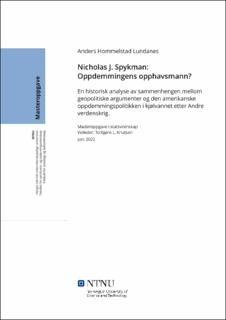| dc.contributor.advisor | Knutsen, Torbjørn Lindstrøm | |
| dc.contributor.author | Lundanes, Anders Hommelstad | |
| dc.date.accessioned | 2022-07-22T17:20:24Z | |
| dc.date.available | 2022-07-22T17:20:24Z | |
| dc.date.issued | 2022 | |
| dc.identifier | no.ntnu:inspera:104661336:25348252 | |
| dc.identifier.uri | https://hdl.handle.net/11250/3007885 | |
| dc.description.abstract | Da Andre verdenskrig endte, og verdensordenen på nytt skulle etableres, stod USA ved et veiskille. De kunne trekke seg tilbake og fungere som en regional hegemon i «the New World», slik de tidligere hadde gjort, eller de kunne involvere seg i verdenspolitikken og maktbalansen på det eurasiske kontinentet. George F. Kennan, som på nært hold hadde observert Sovjetunionens ekspanderende atferd, argumenterte for at statene langs de kystliggende områdene i Europa, spesielt, men også Asia, stod i fare for å havne under kommunistisk kontroll. Gjennom «The Long Telegram» og artikkel «X», opprinnelig «The Sources of Soviet Conduct», legger Kennan de første stenene i en ny strategi for USA: oppdemming. Dette markerte en endring i den amerikanske sikkerhetspolitiske orienteringen. I denne oppgaven søker jeg å identifisere oppdemmingspolitikkens grunnidé. Min hypotese er at denne hviler på et geopolitisk resonnement. Videre er en annen hypotese at denne geopolitiske grunnideen først og fremst stammer fra én geopolitisk tenker: Nicholas J. Spykman. Da det er Kennan som var hovedpersonen bak oppdemmingspolitikken, vil jeg i denne oppgaven ta i bruk historisk analyse, for å kunne finne tidligere sitater og tekster av Kennan, som bærer preg av geopolitiske antakelser. Disse sitatene vil analyseres, og til slutt støtte begge hypotesene: At Kennans oppdemmingspolitikk sannsynligvis er formet av geopolitiske antakelser, og at denne formingen først og fremst er gjort av Spykman. | |
| dc.description.abstract | When World War II ended and a world order was to be re-established, the United States stood at a crossroads. They could retreat and function as a regional hegemon in "the New World", as they had previously done, or they could get involved in world politics and the balance of power on the Eurasian continent. George F. Kennan, who had closely observed the expanding behavior of the Soviet Union, argued that the states along the rimlands of Europe, in particular, but also in Asia, were in danger of falling under communist control. In "The Long Telegram" and article "X", originally named "The Sources of Soviet Conduct", Kennan laid the first stones in a new strategy for the United States: containment. This marked a change in the US security policy orientation. In this thesis, I seek to identify the basic idea of the policy of containment. My hypothesis is that this is based on geopolitical reasoning. Furthermore, another hypothesis is that this geopolitical idea originated primarily from one geopolitical thinker: Nicholas J. Spykman. As it is Kennan who was the main person behind the policy of containment, I will in this thesis conduct a historical analysis of Kennan in order to understand his ideas behind the policy. In this work, I will use previous quotes and texts by Kennan and consider if they are shaped by geopolitical assumptions. These quotations will be analyzed, and finally support both hypotheses: That Kennan's containment policy probably is shaped by geopolitical assumptions; and that this shaping primarily was made by Spykman. | |
| dc.language | nob | |
| dc.publisher | NTNU | |
| dc.title | Nicholas J. Spykman: Oppdemmingens opphavsmann? | |
| dc.type | Master thesis | |
